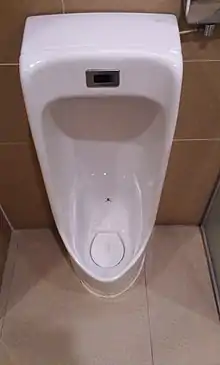Urinal target
A urinal target, sometimes known by the specific types urinal fly or urinal bee, is an image or mark placed inside a urinal to encourage users to aim in a particular place so as to avoid messes and reduce cleaning costs.
_(cropped).jpg.webp)
History
In late-19th century Great Britain, people would put pictures of bees in urinals and toilets. They served as a target, but also a joke about the pronunciation of the honeybee's genus, Apis.[1][2][3] Engineer and businessman Thomas Crapper even put a picture of a bee in the toilets his company produced, down below the water.[4][5] In 1954, an inventor patented a propeller contraption suspended over a toilet, attached from the exterior.[2][6] In 1976 a dentist in New Jersey patented a bullseye decal he called the Tinkle Target, citing how "parents, janitors, and others responsible for this cleanliness have often despaired the human male sloppiness of failing to direct urine into the proper receptacles".[2][6][7]
In the early 1990s, Amsterdam's Schiphol Airport introduced pictures of flies to its men's room urinals in an effort to reduce "spillage", or the amount of urine which spills onto the floor and must then be cleaned. Though sometimes credited to Aad Kieboom, a manager at the airport, according to Kieboom it was the cleaning department's manager, Jos van Bedaf, who had the idea.[2] Van Bedaf remembered, during his time as a soldier in 1960s, that someone had drawn a dot in one of the urinals, and that the latrine with that urinal was cleaner than others. He suggested a fly because, he said, it is the animal people would most like to urinate on.[1] Flies connote unsanitary conditions and are both widely disliked without being frightening like some other disliked insects.[2][8]
They have been installed in urinals at airports, stadiums, and schools in many places around the world.[1][7][9]
Functionality

Urinal design often contends with issues of cleanliness, changing their structure or adding elements like screens to avoid spilling or splashing.[2] Targets are one such intervention to get users to direct a stream of urine to an ideal location.[2] While the flies in the Schiphol Airport urinals are etched, they can also be baked into the porcelain or stuck on as a sticker afterwards.[1] One form of sticker is temperature sensitive, with the fly disappearing when heat is applied.[10]
While flies and bees are well-known, targets can also take the form of written words, a dot, a flag, or a tree.[2][1] Some urinals at the University of Louisville use a logo of the school's rival, the University of Kentucky.[2] In Iceland, some urinals displayed pictures of bankers during the 2008-11 financial crisis.[2] Targets can also be objects like a piece of wood or a Cheerio.[1][2]
Employees of Schiphol Airport conducted trials to test how effective their etched images of flies were. The result was an 80% reduction in spillage, cutting cleaning costs by about 8%.[11]: 4 [2]
Richard Thaler and Cass Sunstein included urinal targets as an example of what they call "nudging" in their 2008 book Nudge: Improving Decisions About Health, Wealth and Happiness.[11] According to nudge theory, positive reinforcement and indirect suggestions can influence the behavior and decision-making of groups or individuals in predictable ways, without using rigid rules.[8] Thaler, a behavioral economist, called it his favorite example of a nudge.[12] Thaler and Sunstein wrote that "It seems that men usually do not pay much attention to where they aim, which can create a bit of a mess, but if they see a target, attention and therefore accuracy are much increased".[11]: 4
References
- Krulwich, Robert (19 December 2009). "There's A Fly In My Urinal". Weekend Edition Saturday. Archived from the original on 22 February 2022. Retrieved 22 February 2022.
- Evans-Pritchard, Blake (Winter 2013). "Aiming To Reduce Cleaning Costs by Blake Evans-Pritchard (Works That Work magazine)". Works That Work. Archived from the original on 27 February 2022. Retrieved 22 February 2022.
- Subich, Anya. "On bees and piss". Mediamatic. Archived from the original on 23 February 2022. Retrieved 23 February 2022.
- Leyland, Simon (2014). A curious guide to London. London. ISBN 978-0-593-07323-0. OCLC 869785117. Archived from the original on 5 March 2022. Retrieved 23 February 2022.
{{cite book}}: CS1 maint: location missing publisher (link) - Quinn, Tom (2005). Science's strangest inventions : extraordinary but true stories from over 200 years of science's inventive history. London. ISBN 978-1-910232-47-7. OCLC 910966138. Archived from the original on 5 March 2022. Retrieved 23 February 2022.
{{cite book}}: CS1 maint: location missing publisher (link) - US 4044405, Kreiss, Joel S., "Target in a bowl or urinal to attract the attention of urinating human males", published 1977-08-30
- "I Invented the First Urinal Target". MEL Magazine. 27 February 2018. Archived from the original on 23 February 2022. Retrieved 23 February 2022.
- Ingraham, Christopher (9 October 2017). "Analysis | What's a urinal fly, and what does it have to with winning a Nobel Prize?". Washington Post. ISSN 0190-8286. Archived from the original on 1 February 2022. Retrieved 23 February 2022.
- Robbins, Christopher (17 June 2012). "The Urinal Flies At JFK's Terminal 4 Keep The Floors Clean". Gothamist. Archived from the original on 14 August 2021. Retrieved 23 February 2022.
- Sparkman, Jeff. "Urinal sticker aims to stem flow of dirty men's rooms". CNET. Archived from the original on 23 February 2022. Retrieved 23 February 2022.
- Thaler, Richard H.; Sunstein, Cass (2008). Nudge : improving decisions about health, wealth, and happiness. Cass R. Sunstein. New Haven, Conn.: Yale University Press. ISBN 978-0-300-12223-7. OCLC 181517463. Archived from the original on 25 January 2022. Retrieved 22 February 2022.
- Sommer, Jeff (7 February 2009). "When Humans Need a Nudge Toward Rationality". The New York Times. ISSN 0362-4331. Archived from the original on 23 February 2022. Retrieved 23 February 2022.